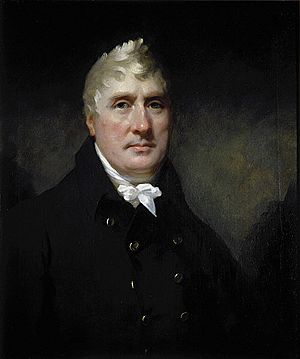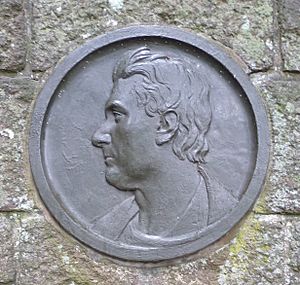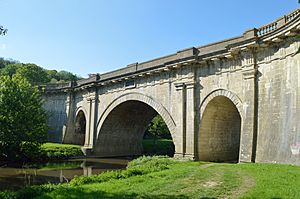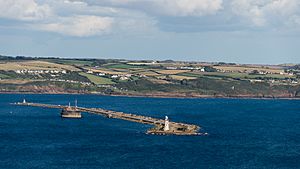John Rennie the Elder facts for kids

John Rennie (born June 7, 1761 – died October 4, 1821) was a Scottish civil engineer. He designed many important structures like bridges, canals, docks, and warehouses. He was also one of the first engineers to use cast iron in his building projects.
Contents
Early Life and Work

John Rennie was born in Scotland, near East Linton. His father was a farmer. From a young age, John loved mechanics. He spent a lot of time in the workshop of Andrew Meikle, who invented the threshing machine.
After finishing school, John went to the University of Edinburgh from 1780 to 1783. He then started his own business as a millwright, building and repairing mills. He was very creative and began using cast iron parts instead of wooden ones in his machines.
In 1784, he traveled south to learn more. He met James Watt, a famous inventor, who offered him a job. Rennie then moved to London to manage the construction of the Albion Flour Mills. He designed all the machinery for the mills, using iron instead of wood for the main parts. Around 1791, he opened his own engineering business in London.
Building Canals and Waterways

After moving to London, John Rennie started working on civil engineering projects, especially building canals. Canals are artificial waterways that allow boats to travel across land.
Some of his early canal projects included:
- The Stowmarket Navigation (1791)
- The Lancaster Canal (started 1792)
- The Chelmer and Blackwater Navigation (1793)
- The Crinan Canal (1794–1801)
- The Rochdale Canal (1799)
He also worked on the Kennet and Avon Canal from 1794 to 1810. This big project included the Dundas Aqueduct (a bridge that carries a canal over a valley), the Caen Hill Locks (a series of steps for boats to go up or down hills), and the Crofton Pumping Station.
Rennie also helped improve rivers and drain marshy areas, like the Fens in Lincolnshire and Norfolk.
Designing Famous Bridges

John Rennie became very well-known for building bridges. He was skilled at combining traditional stone with new cast iron techniques. This allowed him to create bridges with wide, flat arches that looked very elegant.
One of his most famous bridges was the Waterloo Bridge over the River Thames in London (built 1811–1817). It had nine equal arches and a perfectly flat road. Many people thought it was a masterpiece. The famous Italian sculptor Canova even called it "the noblest bridge in the world."
He also designed Wellington Bridge in Leeds and the Southwark Bridge (1815–1819) in London, which used three large cast-iron arches. After Rennie's death, his sons, John Rennie (junior) and George Rennie, built the new London Bridge based on their father's design. This bridge was later moved all the way to Arizona in the USA!
Building Docks and Harbours
Rennie was also a key designer for many docks and harbours. These are places where ships can safely load and unload goods. He worked on projects in cities like Hull, Liverpool, Greenock, London, and Leith. He also improved important naval dockyards at Chatham, Devonport, and Portsmouth.
Dun Laoghaire Harbour
One of Rennie's most challenging projects was the harbour at Dunleary (now Dún Laoghaire) in Ireland. This harbour was vital for connecting Ireland with London. Rennie insisted on building two piers instead of one, to prevent sand from building up. He was right, and the harbour became a success. It was built using granite from a nearby hill.
Custom House Docks, Dublin
Another important project was the Custom House Docks in Dublin, including the CHQ Building. Here, Rennie was a pioneer in using cast iron for building large structures in the early 1800s. The "Tobacco Warehouse" (now the CHQ Building) was built with a roof and supports made entirely of iron, with no wood. This made it very strong and fireproof.
Donaghadee Harbour
Rennie also designed the new harbour at Donaghadee in Northern Ireland. Work began on this harbour in 1821, but Rennie passed away shortly after. His son, John, continued the work. The harbour was built with deep water to handle steamships and used beautiful limestone from Anglesea for its inner walls.
Lighthouses
John Rennie was involved in building the Bell Rock Lighthouse off the coast of Scotland (1807–1810). While Robert Stevenson drew the first plans, Rennie helped get the project approved and was given the title of chief engineer. The lighthouse is a famous example of engineering in difficult conditions.
He also designed the Holyhead Mail Pier Light in Wales, built in 1821. This lighthouse is special because it was originally lit by gas, which was very advanced for its time. He also designed a similar lighthouse in Howth, Ireland.
Plymouth Breakwater
One of Rennie's most impressive works is the Plymouth Breakwater in England. This is a mile-long wall built in the sea to protect ships in Plymouth Sound. It contains millions of tons of stone! Rennie first suggested this huge project in 1806, and construction began in 1811. His son, Sir John Rennie, completed the work after his father's death.
A Creative Engineer
John Rennie was known for his creativity and new ideas. He improved the diving-bell, which is used for underwater work. He is also often credited with inventing a type of steam-powered dredging machine, which uses a chain of buckets to dig out mud from waterways. He used this machine to build the Humber Dock, Hull. He also came up with the idea of using hollow walls for foundations in soft ground, making structures more stable.
Rennie's work was known for being strong and solid, and many of his structures are still standing today. He was very careful in his plans and always made sure to understand the local area before starting a project. He worked very hard, and his dedication to engineering may have shortened his life.
Family and Legacy
In 1790, John Rennie married Martha Ann Mackintosh. They had seven children, and two of his sons, George and John, also became famous engineers.
John Rennie passed away in London on October 4, 1821, after a short illness. He was buried in the crypt of St. Paul's Cathedral.
In 2014, he was honored by being added to the Scottish Engineering Hall of Fame. A locomotive at the Ruislip Lido Railway and a boat at Lancaster Royal Grammar School Boat Club are named after him, showing his lasting impact.
Major Projects
- Lune Aqueduct (1794–97)
- Dundas Aqueduct (1797)
- Kelso Bridge (1800–1804)
- Boston bridge (1800)
- London Docks (1800–05)
- East India Docks (1803–06)
- Humber Dock, Hull (1803–09)
- Greenock Docks (1806)
- Musselburgh bridge (1806–1808)
- West India Docks (consultant, 1809–1821)
- Liverpool Docks (1809)
- Waterloo Bridge (old) (1810–17)
- New Galloway Ken Bridge (1811–21)
- Cree Bridge at Newton Stewart (1812–14)
- Plymouth Breakwater (1812–1841)
- Southwark Bridge (old) (1814)
- Dunleary Asylum Harbour (later Dún Laoghaire Harbour) (1816–1842)
- Donaghadee & Portpatrick Harbours (1819)
- Leeds Bridge (designed 1820)
- Dublin Docks, 'Stack A' warehouse (1820)
- London Bridge (old) (designed 1820, built 1824–31)
- Royal Observatory, Cape of Good Hope Main Building (completed 1828)
- Ruislip Reservoir
- Caen Hill Locks on the Kennet and Avon Canal
|
See also
 In Spanish: John Rennie para niños
In Spanish: John Rennie para niños




